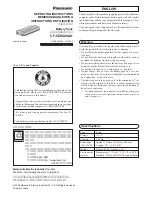
remove personal metallic items such as rings,
bracelets, necklaces and watches. A lead acid
battery can produce a short-circuit current high enough
to weld a ring or similar to metal, which would cause
severe burns.
Ensure hands and clothing are clear of fan blades,
belts and other moving or hot parts of engine.
remove ties and contain long hair.
do not
smoke or allow a spark or flame in the vicinity
of battery or engine.
clean the charger clamps and battery terminals to
remove any oxidation.
Ensure the correct clamp polarity is observed when
connecting to the battery.
positive
is indicated by (+)
and is red,
negative
is indicated by (-) and is black.
do not
pull or carry the charger by its power supply
lead. Products must not be pulled or carried by their
output cables.
do not
pull power plugs from sockets by the power
cable.
do not
attempt to charge a non-rechargeable battery.
do not
use the charger for any purpose other than
that for which it is designed.
do not
allow the charger terminal clamps to touch
each
other when the power is on. remember that
gases are produced which may ignite if sparks occur.
do not
place the charger inside the vehicle.
remove the battery to a safe distance for charging.
do not
get the charger wet or use in damp or wet
locations or areas where there is condensation.
do not
operate the charger if damaged.
do not
attempt to modify or open the charger.
When not in use unplug from the mains power supply
and store in a safe, dry, childproof area.
do not
allow untrained persons to operate the charger.
this appliance is not intended for use by persons
with reduced physical, sensory or mental capabilities, or
lack of experience and knowledge, unless they have
been given instruction concerning the use of the
appliance and are supervised by a person responsible
for their safety.
Keep children and unauthorised persons away from the
working area. children must not use the charger and should
be constantly supervised to ensure they do not play with the
charger.
WARNING!
Be vigilant and cautious during the
operation of battery charging as the electrolyte is
highly corrosive and any gases emitted are explosive.
DANGER! BE AWARE, LEAD ACID, GEL, AGM,
VRLA, AND LIQUID ELECTROLYTE BATTERIES
GENERATE EXPLOSIVE GASES DURING NORMAL
BATTERY OPERATION. FOR THIS REASON, IT IS
VERY IMPORTANT TO READ AND FOLLOW THESE
INSTRUCTIONS CAREFULLY, EACH TIME YOU
USE THE CHARGER.
Follow these instructions and those published by the
battery and vehicle manufacturers and the manufacturer
of any equipment you intend to use in the vicinity of
the battery. Remember to review warning marks on all
products and on engines.
1.3
personal precautions
Ensure there is another person within hearing range
of your voice, or close enough to come to your aid,
should a problem arise when working near a lead acid
battery.
Wear safety eye protection and protective clothing.
Avoid touching eyes while working near battery.
Have fresh water and soap nearby in case battery acid
contacts skin, clothing or eyes.
Wash immediately with soap and water if battery acid
contacts skin or clothing. if acid enters eye, flush eye
immediately with cool, clean running water for at least
15 minutes and seek immediate medical attention.
2. introduction
Plug in, connect to the battery and the charger does the
rest. this charger uses inverter technology with micro-
chip management to read the battery condition and
adjust its behaviour to optimise the battery charging
process. this charger has multiple charging cycles
with profiles designed to cram the battery with the
maximum amount of charge in the most effective time
period and, having done this, maintain it at this level.
the chargers can be connected indefinitely to the
battery and cycle between a maintenance and a float
charge. safety is also assured. this model has
protection against polarity reversal and shorting out of
clamps.
3. connection to battery
specification
MoDEL no:
sMc01
input Voltage
230V
output Voltage
12V
starting current
26A
input current
0.22A
Efficiency
>75%
charging Voltage
12V
charging current
1.5A
Back current Drain
10mA
Ambient temperature
-10°c to +40°c
type of Batteries
AGM, VrLA, GEL, Pb/ca
Battery capacity
5 - 60Ah/12V
Dimensions (LxWxH)
119 x 55 x 25mm
Weight:
0.4 kg
notE: tHE cHArGEr sHouLD BE connEctED to tHE
BAttErY BEforE connEctinG to tHE MAins suPPLY.
3.1
the output cable from the charger terminates in a socket
to which two alternative leads can be connected. (see fig.1)
3.1.1 one lead set has two colour coded battery clamps which
can be quickly attached to and detached from the battery
posts.
3.1.2 the second lead terminates in colour coded eyelets
(Ø10mm) intended for permanent connection to a battery.
3.2
battery permanently installed in a vehicle.
3.2.1 identify the polarity of the battery terminals which are
usually marked on the battery casing. if it is not clear,
the positive battery post is usually a larger diameter
than the negative post.
3.2.3 identify the polarity of the battery pole connected to
the chassis (earth). this will normally be the negative
terminal.
Original Language Version
sMc01 issue: 4(sP) - 18/07/13
© Jack sealey Limited





















